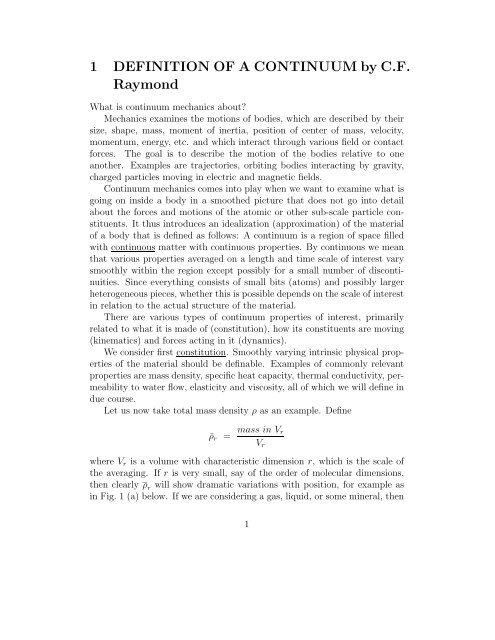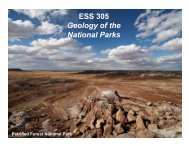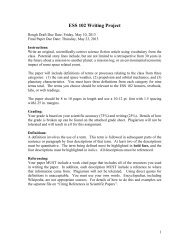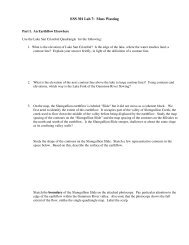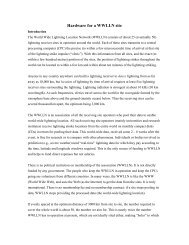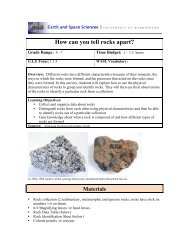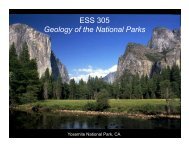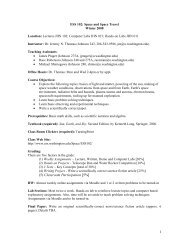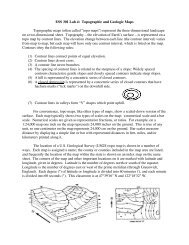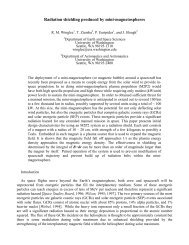Definition of a continuum. - Earth and Space Sciences
Definition of a continuum. - Earth and Space Sciences
Definition of a continuum. - Earth and Space Sciences
You also want an ePaper? Increase the reach of your titles
YUMPU automatically turns print PDFs into web optimized ePapers that Google loves.
1 DEFINITION OF A CONTINUUM by C.F.<br />
Raymond<br />
What is <strong>continuum</strong> mechanics about<br />
Mechanics examines the motions <strong>of</strong> bodies, which are described by their<br />
size, shape, mass, moment <strong>of</strong> inertia, position <strong>of</strong> center <strong>of</strong> mass, velocity,<br />
momentum, energy, etc. <strong>and</strong> which interact through various field or contact<br />
forces. The goal is to describe the motion <strong>of</strong> the bodies relative to one<br />
another. Examples are trajectories, orbiting bodies interacting by gravity,<br />
charged particles moving in electric <strong>and</strong> magnetic fields.<br />
Continuum mechanics comes into play when we want to examine what is<br />
going on inside a body in a smoothed picture that does not go into detail<br />
about the forces <strong>and</strong> motions <strong>of</strong> the atomic or other sub-scale particle constituents.<br />
It thus introduces an idealization (approximation) <strong>of</strong> the material<br />
<strong>of</strong> a body that is defined as follows: A <strong>continuum</strong> is a region <strong>of</strong> space filled<br />
with continuous matter with continuous properties. By continuous we mean<br />
that various properties averaged on a length <strong>and</strong> time scale <strong>of</strong> interest vary<br />
smoothly within the region except possibly for a small number <strong>of</strong> discontinuities.<br />
Since everything consists <strong>of</strong> small bits (atoms) <strong>and</strong> possibly larger<br />
heterogeneous pieces, whether this is possible depends on the scale <strong>of</strong> interest<br />
in relation to the actual structure <strong>of</strong> the material.<br />
There are various types <strong>of</strong> <strong>continuum</strong> properties <strong>of</strong> interest, primarily<br />
related to what it is made <strong>of</strong> (constitution), how its constituents are moving<br />
(kinematics) <strong>and</strong> forces acting in it (dynamics).<br />
We consider first constitution. Smoothly varying intrinsic physical properties<br />
<strong>of</strong> the material should be definable. Examples <strong>of</strong> commonly relevant<br />
properties are mass density, specific heat capacity, thermal conductivity, permeability<br />
to water flow, elasticity <strong>and</strong> viscosity, all <strong>of</strong> which we will define in<br />
due course.<br />
Let us now take total mass density ρ as an example. Define<br />
¯ρ r<br />
= mass in V r<br />
V r<br />
where V r is a volume with characteristic dimension r, which is the scale <strong>of</strong><br />
the averaging. If r is very small, say <strong>of</strong> the order <strong>of</strong> molecular dimensions,<br />
then clearly ρ r will show dramatic variations with position, for example as<br />
in Fig. 1 (a) below. If we are considering a gas, liquid, or some mineral, then<br />
1
Figure 1: Density <strong>of</strong> a material averaged over dimensions that are similar to<br />
(a) <strong>and</strong> much larger (b) than the spacings <strong>of</strong> constituent molecules or atoms.<br />
if r is much larger than molecular dimensions, ρ r is well defined <strong>and</strong> changes<br />
only slowly with position as in Fig. 1 (b).<br />
Another illustrative example <strong>of</strong> a constitutive property is thermal conductivity.<br />
What can be said about the thermal conductivity <strong>of</strong> a rock composed<br />
<strong>of</strong> grains <strong>of</strong> differing minerals, say a granite. Granite is an aggregate <strong>of</strong> several<br />
minerals: feldspar, quartz, biotite, <strong>and</strong> others. Each mineral grain can<br />
safely be considered a <strong>continuum</strong> on averaging scales smaller than the grain<br />
size (typically order 1 millimeter) <strong>and</strong> larger than molecular dimensions. To<br />
some extent the different mineral types have different thermal conductivity.<br />
If we were to consider heat flow with spatial resolution on the order <strong>of</strong> a single<br />
or small number <strong>of</strong> grain sizes, then the relevant thermal conductivity would<br />
show substantial local variations. On this scale we would have to deal with<br />
the properties <strong>of</strong> each constituent mineral <strong>and</strong> there is no well-defined single<br />
<strong>continuum</strong>. We would have to consider it as a complex aggregate <strong>of</strong> discrete<br />
continua <strong>and</strong> take account <strong>of</strong> all <strong>of</strong> the boundaries between them. On the<br />
other h<strong>and</strong>, if we consider an averaging scale that is much larger than the<br />
grain size, then the thermal conductivity would vary smoothly. On this scale<br />
we can think <strong>of</strong> a single <strong>continuum</strong>, granite, with its own properties which<br />
represent some sort <strong>of</strong> average <strong>of</strong> the properties <strong>of</strong> the constituent minerals.<br />
Now we consider kinematics. In a <strong>continuum</strong> it must be possible to define<br />
local displacement <strong>and</strong> velocity that vary continuously, except possibly for<br />
2
Figure 2: Continuum view <strong>of</strong> a rock at different scales.<br />
a small number <strong>of</strong> discontinuities on internal boundaries called faults. That<br />
means that the description may be constrained to appropriate spatial <strong>and</strong><br />
temporal averaging scales.<br />
In a gas individual molecules have an extreme range <strong>of</strong> velocities associated<br />
with thermal motions, but with an averaging scale which includes a<br />
very large number <strong>of</strong> molecules it is possible to define a mean velocity which<br />
in our ordinary experience is wind speed. In deforming s<strong>and</strong>, the displacement<br />
<strong>and</strong> velocity <strong>of</strong> pieces <strong>of</strong> matter on the scale <strong>of</strong> individual s<strong>and</strong> grains<br />
is very discontinuous, but smoothly varying quantities can be defined with a<br />
larger scale. Consider also turbulent water or other fluid. On a small scale<br />
there may be irregular disorganized motion (turbulence). Although this small<br />
scale motion is present, principal interest may be in a larger scale view <strong>of</strong> the<br />
motion. The contributions to the motion from eddies can be averaged out;<br />
then the <strong>continuum</strong> is not regular water but turbulent water with different<br />
viscosity <strong>and</strong> diffusion properties.<br />
With regard to forces, it should be possible to define force densities<br />
which vary continuously. There are two main types. The first type is called<br />
volume force <strong>and</strong> is the force on unit volume <strong>of</strong> material arising from some<br />
force field. In geophysics the most common volume force is the force <strong>of</strong> gravity<br />
acting on a material with a well-defined mass density. Another example<br />
is an electric field acting on a well-defined charge density. The second type is<br />
called surface force <strong>and</strong> is the force acting across unit area <strong>of</strong> any internal or<br />
external surface. The first <strong>of</strong> these is <strong>of</strong>ten called body force <strong>and</strong> the second<br />
3
is usually called stress or sometimes traction.<br />
If one considers some <strong>of</strong> the earlier examples, it is clear that there is also<br />
a problem <strong>of</strong> scale in defining the body force <strong>and</strong> stress. Air pressure is a<br />
surface force (stress) that arises from the time/space average <strong>of</strong> molecules<br />
impinging on a surface. Stress in deforming s<strong>and</strong> would represent the mean<br />
force per unit area arising from the local forces acting across particle contacts.<br />
The question <strong>of</strong> whether a material (or materials) can be considered a<br />
<strong>continuum</strong> for the solution <strong>of</strong> some practical problem or analysis <strong>of</strong> some<br />
data is <strong>of</strong>ten a subjective matter. The concept <strong>of</strong> a <strong>continuum</strong> is an idealization,<br />
which may approximate reality, when one looks in appropriate distance<br />
<strong>and</strong> time averages. Usually in geophysics we find examples where the concept<br />
<strong>of</strong> a <strong>continuum</strong> is clearly applicable. A dense plasma, atmospheric air,<br />
ocean water, glacier ice, a large body <strong>of</strong> granite are examples. However, there<br />
are cases where the answer is not so clear. Suppose a large body <strong>of</strong> granite<br />
is cracked (has joints) every several or several tens <strong>of</strong> meters <strong>and</strong> we consider<br />
some relevant constitutive property, for example, the way water moves<br />
through it (permeability). As a whole the body will not behave the same<br />
way as a small sample <strong>of</strong> coherent granite behaves in a lab test. Possibly on<br />
an averaging scale <strong>of</strong> several hundred meters we could idealize the body as<br />
a <strong>continuum</strong> (e.g. permeability <strong>of</strong> cracked granite), but this is not always<br />
obvious.<br />
The goal <strong>of</strong> <strong>continuum</strong> mechanics is to predict the distribution <strong>of</strong> displacements<br />
<strong>and</strong> forces within a body when prescribed forces <strong>and</strong>/or displacements<br />
are applied to its outer surface. To do this we must learn how to (1) describe<br />
the essential aspects <strong>of</strong> the displacement field, (2) describe the state <strong>of</strong> forces,<br />
<strong>and</strong> (3) have knowledge <strong>of</strong> the mechanical behavior <strong>of</strong> the material (i.e., kinematic<br />
response to certain forces). Essentially this boils down to learning how<br />
to predict the response <strong>of</strong> an arbitrary continuous body under arbitrary surface<br />
loads or displacements from the results <strong>of</strong> several simple experiments<br />
such as stretching a rod or twisting a cylinder. This is especially successful<br />
when the <strong>continuum</strong> is one on a scale <strong>of</strong> mm, cm, or even meters which can<br />
be h<strong>and</strong>led in the lab. In geophysics we are <strong>of</strong>ten stuck with a larger scale<br />
<strong>and</strong> must rely on natural experiments.<br />
4


